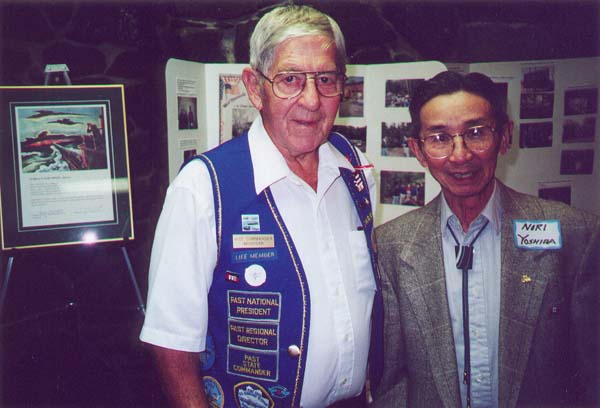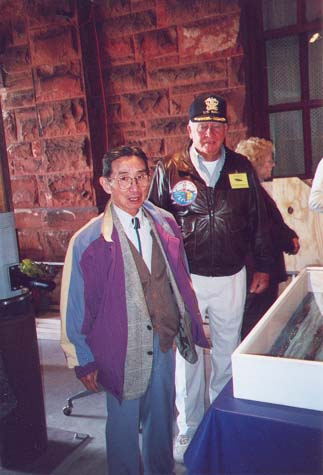


March 23, 1924 -- Born in Chemainus, British Columbia, Canada.January 30, 1938 -- Left Canada for Japan to study.
May 1, 1942 -- Join Japanese Imperial Navy. Yokosuka Base for Naval seaman training.
Early October, 1942 -- To Truk Island, assigned to heavy cruiser Maya.
November 3, 1942 -- Maya left Truk Iasland for Guadalcanal airfield bombardment operation. Assembled at Shortland.
November 13, 1942 -- Left Shortland for Guadalcanal Island, started firing at 11 PM for about one hour. Fired 500 (?) rounds from 10-20cm turret.
November 14, 1942 -- 3rd Solomon Naval Battle was in action surrounding Guadalcanal Island and Solomon Island Sea. Maya was attacked by enemy planes. One fighter plane could not dodge away and plunged into our cruiser Maya, and caused fire. Fire spread to #3 high angle gun shell storage space (?) and possible it may ignite to torpedoes at #3 torpedo station, so 4 torpedoes were cast into sea. I was slightly injured at my post ("aircraft ?). Maya returned to Yokosuka for minor repairs.
January to April, 1943 -- Attended Torpedo School.
April, 1943 -- After completion of Torpedo School, I was again assigned to cruiser Maya as torpedo crew member. At this time, Maya alone was temporarily assigned to Northern Fleet (?? anchored at OMINATE post.)
June, 1943 -- Army unit evacuation from Kiska Island. After this operation, Maya went back to his original 4th Fighting Squadron in Pacific area on July 3, 1943.
November 5, 1943 -- Maya, while refueling at Rabaul Naval Base, was attacked by U.S. aircraft carrier planes, "total about 100 planes." Maya was badly damaged and also heavy casualties, 70 killed, 60 injured. November 11, still under attack, Maya escaped to Truk Island. After temporary repairs, headed for home base, Yokosuka, for complete repair and recontruction as Anti-Aircraft Cruiser.
June 15, 1944 -- Left "Gimalas Port" to Saipan Island. ???
June 20, 1944 -- On June 20 evening Maya was attacked by about 200 planes, one bomb exploded near my station. I was hit and was unconscious, later gained consciousness to find myself burning, immediately jumped into saltwater reserve tank. Fellow seaman beside me was killed. Maya went back to Yokosuka for minor repairs and back to her Squadron on July 29.
September 20, 1944 -- Our 4th Fighting Squadron was given a new duty as 1st Flying "Guerilla" Unit and assembled at Brunei port.
October 22, 1944 -- At 8 PM our 1st Flying "Guerilla" Unit departed Brunei port and headed for Gulf of Leyte called SHO #1 Naval Operation.
October 23, 1944 -- 06:57 at Palawan Channel Maya was hit by 4 submarine torpedoes that were fired by U.S. submarine Dace. Sank in 7 minutes. We were rescued by destroyer Shimakaze. Later she was crippled and sank. We Maya crew members were transferred to battleship Musashi.
Musashi with rest of Fleet was in open-sea during daylight and bombarded Leyte Island at night.
Japanese Fleets at open sea was attacked by about total 1,000 attack a day. Musashi was badly damaged by torpedo and bomb attack. "Out of commission" Sank October 25.
October 24, 1944 -- We Maya crew were transferred to repair ship Akashi. Head for homeland. At homeland, we Maya crew was confined in remote area for security reasons.
January, 1945 -- After release from confinement, I was assigned to 1st Yokosuka Naval Base mountain-top machine gunner.
June, 1945 -- Training as suicide unit and was stationed at entrance of Bay of Tokyo.
August 15, 1945 -- End of War.
